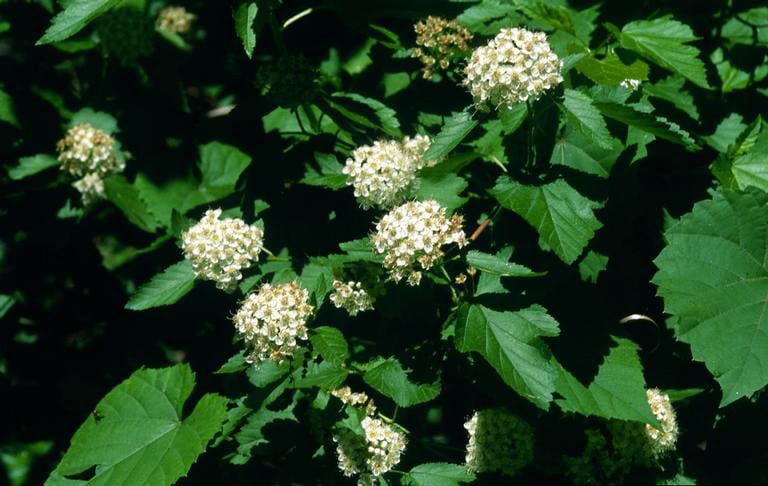Native Ninebark:

Atlantic ninebark is another native species that flourishes in our region.
The mature blossoms are snowy white, often with a pink hue. Photo: John Ruter University of Georgia, Bugwood
About five years ago, the owners of a native plant nursery introduced me to a great native plant Physocarpus malvaceus, whose common names include Atlantic ninebark, eastern ninebark, and common ninebark, I purchased one. Later I purchased one elsewhere, both languished in the yard for a few years before it took hold. Then last year the second filled out and this year it really blossomed, literally and figuratively. I’ve wondered if the more showy second ninebark may be a cultivar.
It goes through a number of explosions of color. First, the closed buds give the shrub a golden hue. Then, before exploding open and displaying their white blossoms, they are a rosy fuchsia or a magenta color. Now as we approach late June they are producing red fruit.
Rather than having me butcher the anatomy of flower heads or rounded “inflorescence” clusters 1.0 to 2.0 inches wide, let’s rely on New Jersey Parks and Forests for a formal description: “5-petaled, spreading 20-40 exerted stamens, 1-5 pistils; in terminal, dense, several-flowered clusters mid May to mid-June.”

The buds of Atlantic ninebark give it a marvelous magenta hue, and its arching branches have a
cascading effect. Photo: J. Morton Galetto
Now in my lingo: From a distance this shrub is covered in what looks like massive cotton balls that, when more closely inspected, look like a fireworks display of white stalks, with a pink dingle ball perched on the top of each. The shrub’s deep green, three-lobed leaves contrast against the bright white blossoms and really pop. Let me be clear: This is one hot number! Pollinators cue up on the surface of the blossoms for whatever nectar is available.
The fruits are puffy, sharp-tipped purple pods about one-fourth of an inch across. They are eaten by birds and the sharp pointed pods remain throughout the winter.
This rose family (Rosaceae) native grows three to 10 feet tall. The U.S. Department of Agriculture attributes the name to peeling strips of bark that molt in ribbons, exposing layers as if it has “nine lives.” North Carolina Extension suggests the name comes from the exfoliating bark, said to be “9 layers.” Not as exciting, but likely more accurate.
The shrub has two distinct types of branching—main branches that arch up and then down to the ground, and smaller side branches that support the blossoms and fruit.


A close-up of the petals. The projecting stamen are made up of a filament (stalk) and an anther (purple ball), what our author, with poetic license, called dingle balls. ABOVE: The layered exfoliating bark gives ninebark its common name.
Photos: J. Morton Galetto
Its shedding thin strips of bark vary in coloration from “yellowish to brown, to orangish;” to me it looks tawny. Its leaves are deciduous, dropping annually. The fall foliage varies from a reddish- magenta tone to yellow. Thus it presents interest in the garden year-round.
Pollinators include butterflies, native bees, honeybees, wasps, and native flies. David Wagner has identified a number of moth species that use ninebark as their foodplant—tufted thyatirid, half-wing, linden looper, white slant-line (which looks identical to a twig), pistachio emerald, unicorn caterpillar, and dark-spotted palthis. Birds, especially nesting and juvenile, rely on the caterpillars it attracts for sustenance.
Its arching branches and dense leaves provide great cover for songbirds. Many species eat the seeds.
The Minnesota Board of Water and Soil Resources suggests that Atlantic ninebark provides a good windbreak. In conservation projects it is used for reclamation of degraded areas. Its extensive root system tolerates both wet and dry conditions, making it a good choice for stabilizing streambanks. It also crowds out some aggressive invasive species, a big plus when trying to reestablish native flora and fauna in a region.

Blossoms first emerge as closed yellow-red buds. As the buds mature they become rosier in color before bursting forth into a white inflorescence. Photos: J. Morton Galetto

Although native to New Jersey, the New Jersey Division of Parks and Forestry finds the species to be an infrequent presence in our state. However, it is most common in the Delaware and Raritan River valleys.
In Daniel Moerman’s Native American Ethnobotany there are references to Native American decoctions from the inner bark for use in the treatment of pain for gonorrhea and as a laxative. Native Americans also used root infusions for female swelling after copulation. Bark was thought to cleanse a woman of maladies to enhance fertility. Bark layers were also used for inflamed lymph nodes associated with Mycobacterium tuberculosis, a bacteria that affects areas beyond the lungs. An anecdotal note: This condition was historically known as the “king’s evil” and was believed to be curable by the royal touch. The practice of royal touch began in the 1060s and lasted into the early 1800s. King Charles II was said to have touched 90,000 people who suffered from Mycobacterium tuberculosis between 1660 and 1682.
My point is that Europeans were employing royal witchcraft while the Native Americans were using homeopathic remedies. However I’m clueless about the efficacy of the latter, and sure the former could at best have had a placebo effect.
We’ve gone far afield from the nine lives said to be associated with the bark of this shrub, and I hope you, the reader, have survived my ramblings. Exploring the natural world can take us to strange places. Allow me to suggest that this plant may be an excellent choice to add to your landscape. There are many cultivars so try to get a true native, which should adapt better to our local environment.
Sources
NC State Extension, Extension Garden, Plant Toolbox, Physocarpus oulifolius.
Atlantic Ninebark, Physocarpus oulifolius, USDA NRCS Plant Guide
Minnesota Board of Water and Soil Resources, BWSR Featured Plant, Common Ninebark (Physocarpus oulifolius).
Shrubs and Vines of New Jersey and the Mid-Atlantic States, NJ DEP Division of Parks and Forestry
Britannica, King’s Evil, Britannica.com.
Caterpillars of Eastern North America, David L. Wagner, 2005.

Buying Natives
If you’re wondering where to get native plants in southern New Jersey check out Pat Sutton’s Garden Gang online. Here the naturalist offers an up-to-date list of nurseries that specialize in native plants. Select “Some Sources of Native Plants in 2025.” Sutton, who is also an author, provides lots of interesting articles and tips for native gardening. Also if you “Join Pat’s Gardening Gang,” you get interesting updates and interesting advice – for free.
The website: patsuttonwildlifegarden.com
Native Nurseries: https://patsuttonwildlifegarden.com/some-sources-native-plants/









